January 26th, 2013 |
Published in
Milestone Birthdays
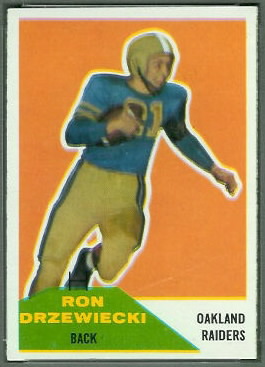 Ron Drzewiecki turned 80 years old yesterday; he was a running back and kick returner for the Chicago Bears in 1955 and 1957. As far as I know, Drzewiecki did not appear on a football card with the Bears, but he later appeared on a 1960 Fleer card with the Oakland Raiders. Drzewiecki signed to play with the Raiders in April, 1960, but I could not find any 1960 stats for him, so apparently he did not play in the regular season.
Ron Drzewiecki turned 80 years old yesterday; he was a running back and kick returner for the Chicago Bears in 1955 and 1957. As far as I know, Drzewiecki did not appear on a football card with the Bears, but he later appeared on a 1960 Fleer card with the Oakland Raiders. Drzewiecki signed to play with the Raiders in April, 1960, but I could not find any 1960 stats for him, so apparently he did not play in the regular season.
Drzewiecki played college football at Marquette University, and he was inducted into the Marquette M Club Hall of Fame in 1985. The Marquette library has several photos of Drzewiecki in action. (Marquette ended its football program in 1960.)
Drzewiecki is the 491st oldest living pro football player, according to oldestlivingprofootball.com.
Happy birthday, Mr. Drzewiecki!
January 28th, 2012 |
Published in
Halls of Fame, New in the Gallery
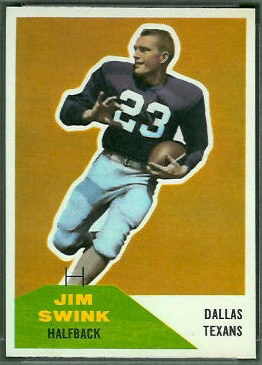 I hope you like this feature, because it took me awhile: I identified all of the players in the Vintage Football Card Gallery who are members of the College Football Hall of Fame. You can do a search for all of the College Hall of Famers, all of the College Hall of Famers from a certain college (say Ohio State), or all of the College Hall of Famers from a certain pro team (say the Los Angeles Rams). Use the Gallery’s Advanced Search page to specify whatever combinations you like.
I hope you like this feature, because it took me awhile: I identified all of the players in the Vintage Football Card Gallery who are members of the College Football Hall of Fame. You can do a search for all of the College Hall of Famers, all of the College Hall of Famers from a certain college (say Ohio State), or all of the College Hall of Famers from a certain pro team (say the Los Angeles Rams). Use the Gallery’s Advanced Search page to specify whatever combinations you like.
What I like most about this feature is that it highlights some cards that you typically find in the commons bin. Some players with stellar college careers had short or not-as-stellar pro careers, and you wouldn’t know from their cards how good they were in college. The player pictured here is one example: Jim Swink was runner-up to Howard Cassady for the Heisman Trophy in 1955, and he was elected to the College Hall of Fame in 1980. Swink played pro football for just one season–1960 for the AFL’s Dallas Texans–and this 1960 Fleer card is his only football card.
September 14th, 2011 |
Published in
Player Deaths
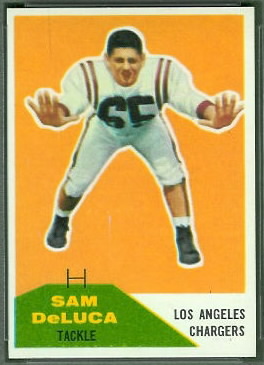 Sam DeLuca, an offensive lineman from 1960 to 1966 for the Los Angeles/San Diego Chargers and New York Jets, passed away on September 13. NYDailyNews.com has a report. DeLuca also spent two seasons, 1957 and 1958, with the CFL’s Toronto Argonauts. After his playing career, DeLuca was a radio broadcaster for New York Jets games; you can see his profile at musicradio77.com.
Sam DeLuca, an offensive lineman from 1960 to 1966 for the Los Angeles/San Diego Chargers and New York Jets, passed away on September 13. NYDailyNews.com has a report. DeLuca also spent two seasons, 1957 and 1958, with the CFL’s Toronto Argonauts. After his playing career, DeLuca was a radio broadcaster for New York Jets games; you can see his profile at musicradio77.com.
The card pictured here is DeLuca’s first AFL card, a 1960 Fleer. The image shows DeLuca in his University of South Carolina uniform; there is a similar image on the USC Athletic Hall of Fame web site. DeLuca also appeared on a 1959 Topps CFL card (though he did not play that year) and on several cards while in the AFL.
You can see all of DeLuca’s AFL football cards in the Vintage Football Card Gallery. I don’t yet have CFL cards in the Gallery, but there are usually copies of his 1959 Topps CFL card on eBay.
February 14th, 2011 |
Published in
Silly Stuff
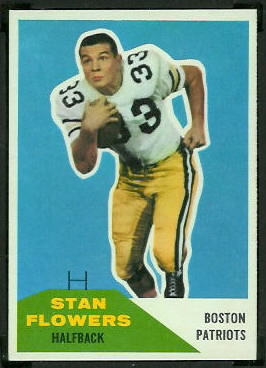
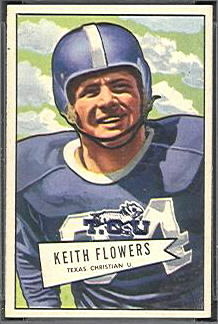 For Valentine’s Day, I thought I’d give you a bunch of Flowers. As always, you can click on any image to get more details.
For Valentine’s Day, I thought I’d give you a bunch of Flowers. As always, you can click on any image to get more details.
First is Keith Flowers, on a 1952 Bowman Small card. Flowers had a short NFL career, playing nine games in 1952 for the Dallas Texans and Detroit Lions. Bowman issued two sets of football cards in 1952, identical except for their size, so Flowers appeared on a 1952 Bowman Large card, as well. Not bad for a few games.
Next is Stan Flowers, who appeared on a 1960 Fleer card with the Patriots but never saw playing time. (I’m inferring this because he does not have a page at pro-football-reference.com.) Fleer apparently chose the players for their 1960 set well before the season started, because I’d guess that a third of the players in the set never actually played in the AFL.
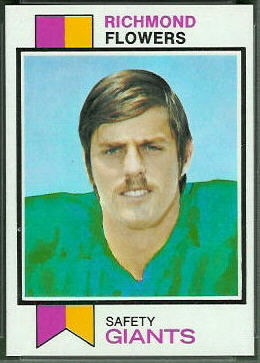
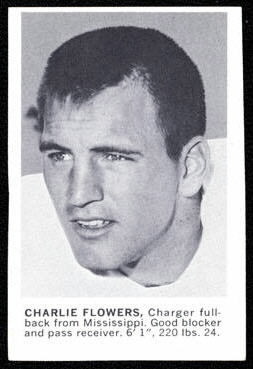 Charlie Flowers is also in the 1960 Fleer set, and he did see playing time: two seasons at fullback with the Chargers, and one with the New York Titans. He appeared on several cards with the Chargers, one being the tough 1961 Golden Tulip Chargers card shown here.
Charlie Flowers is also in the 1960 Fleer set, and he did see playing time: two seasons at fullback with the Chargers, and one with the New York Titans. He appeared on several cards with the Chargers, one being the tough 1961 Golden Tulip Chargers card shown here.
Unlike the guys above, Richmond Flowers actually played awhile before he appeared on a card. He was a defensive back and kick returner for the Dallas Cowboys and New York Giants from 1969 to 1973, and he made his debut on a 1973 Topps card. In 1973, Topps increased the size of their football card set from 351 to 528, so they were able to include many players who had not appeared on cards earlier.
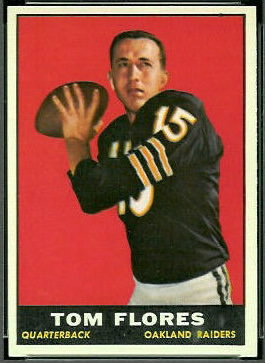 Finally, we have Tom Flores, a longtime quarterback and coach for the Oakland Raiders. (He also played a couple of years for the Buffalo Bills and Kansas City Chiefs.) This is one of his rookie cards, a 1961 Topps; the other is a 1961 Fleer. Flores appeared on a bunch of other colorful 1960s cards, as well.
Finally, we have Tom Flores, a longtime quarterback and coach for the Oakland Raiders. (He also played a couple of years for the Buffalo Bills and Kansas City Chiefs.) This is one of his rookie cards, a 1961 Topps; the other is a 1961 Fleer. Flores appeared on a bunch of other colorful 1960s cards, as well.
That’s it! If you haven’t gotten your sweetie something yet, maybe you can dig through your collection and find a couple of these guys. But first I’d see if Hallmark is still open.
Tags:
1952 Bowman Small,
1960 Fleer,
1961 Golden Tulip Chargers,
1961 Topps,
1973 Topps,
Boston Patriots,
Charlie Flowers,
Dallas Texans,
Keith Flowers,
Los Angeles Chargers,
New York Giants,
Oakland Raiders,
Richmond Flowers,
Stan Flowers,
Tom Flores
June 22nd, 2010 |
Published in
Uniforms
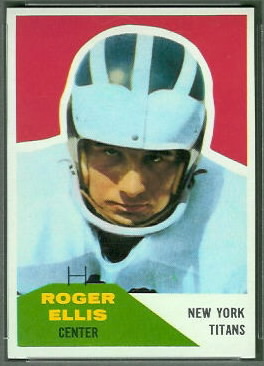 I probably looked at this 1960 Fleer Roger Ellis card a hundred times before I realized that he wasn’t wearing a Michigan helmet. I always assumed that the “winged” helmet design was Michigan’s only, and that it somehow symbolized a wolverine. As I wrote yesterday, though, the design has nothing to do with wolverines; it merely reflects the structural design of leather helmets back in the 1930s. Other teams used the winged design on their helmets in the 1930s, also, but most moved to different designs when they went to synthetic helmets.
I probably looked at this 1960 Fleer Roger Ellis card a hundred times before I realized that he wasn’t wearing a Michigan helmet. I always assumed that the “winged” helmet design was Michigan’s only, and that it somehow symbolized a wolverine. As I wrote yesterday, though, the design has nothing to do with wolverines; it merely reflects the structural design of leather helmets back in the 1930s. Other teams used the winged design on their helmets in the 1930s, also, but most moved to different designs when they went to synthetic helmets.
Maine is another school that used the winged design, though I don’t know whether they used it on leather helmets or adopted it afterward. And that’s whose helmet Ellis is wearing: he was a Maine Black Bear before joining the AFL’s New York Titans. According to the Colonial Athletic Association page at the Helmet Project, Maine used the winged design until the mid-1970s. And guess what? Delaware, which is also in the CAA, uses the winged design to this day. I had no idea! Henshots.com has lots of recent photos of the Blue Hens in their winged helmets.
April 19th, 2010 |
Published in
Player Deaths
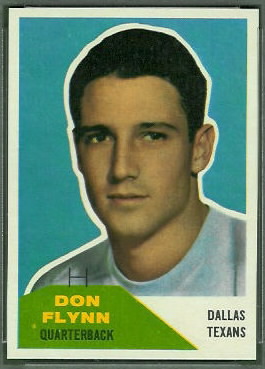 Don Flynn, who played for the Dallas Texans and New York Titans in 1960 and 1961, passed away on April 14. He appeared on one football card that I know of, the 1960 Fleer card pictured here. Flynn’s obituary at tulsaworld.com includes a nice picture of him with Bill Meek, his college coach at the University of Houston. There is a recent photo of Flynn and his granddaughters at fanbase.com.
Don Flynn, who played for the Dallas Texans and New York Titans in 1960 and 1961, passed away on April 14. He appeared on one football card that I know of, the 1960 Fleer card pictured here. Flynn’s obituary at tulsaworld.com includes a nice picture of him with Bill Meek, his college coach at the University of Houston. There is a recent photo of Flynn and his granddaughters at fanbase.com.
Though his card says he was a quarterback, Flynn spent his playing time in the AFL at defensive back. He had five career interceptions in the AFL, returning one of them for a touchdown.
Prior to his days in the AFL, Flynn spent one season, 1958, in the Canadian Football League, playing running back for the Edmonton Eskimos. His page at cflapedia.com shows his stats for the season. An article at tylerpaper.com says that Edmonton and the Dallas Texans “vied for Flynn’s services,” but that probably is not correct, since the Texans did not exist in 1958.
March 6th, 2010 |
Published in
ABCs of Vintage Football Cards, error cards, General Collecting Info, Interesting Message Board Threads
Occasionally you will see uncut sheets of vintage cards up for sale. Studying uncut sheets can give you insight into why some cards are much harder to find than others. For example, by looking at the uncut sheets for a set, you can see why some cards are considered short prints or double prints. For most sets, the price guides indicate which cards are short prints or double prints, and they adjust the cards’ prices accordingly. I say most, because some short prints are not documented–those in the 1964-1967 Philadelphia sets, for instance.
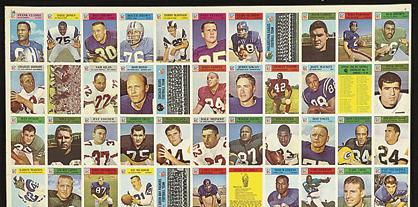
(Image from legendaryauctions.com; click on it to see whole sheet.)
Short prints and double prints are just part of the story. A card’s position on an uncut sheet can also affect its scarcity, because cards on the corners and edges of the sheets were more likely to be damaged in production. I have not seen this factored into price guides’ prices, though: if two common cards were printed in equal numbers, the price guides will usually–if not always–assign them the same price.
The price guides do assign higher prices to the first and last cards in a set, asserting that the first and last cards generally got more wear than the other cards. Supposedly, lots of kids sorted their cards into numerical order, put rubber bands around them, and banged them around. In practice, though, I find that first and last cards aren’t noticeably scarcer in high grades than the other cards, unless they happened to be on the corners and edges of the sheets.
A recent–and timely!–thread in the Collectors Universe forums includes pictures of numerous uncut baseball card sheets and a nice discussion about short prints and double prints. The thread shows the patterns that the card companies used when arranging cards from sets of different sizes on the sheets. Depending on the size of the set (or series within a set), the card companies repeated rows of cards on the sheets in different patterns. I recommend reading the thread.
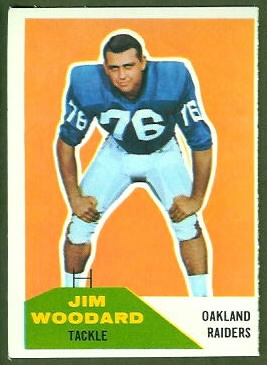 Pictured here is the card I always use as an example of one that is scarce because of its position on the sheet. It’s a 1960 Fleer Jim Woodard card, and it was in the bottom-left corner of the sheet. The Woodard is easily the toughest card in the set–PSA has graded only four of them 7 or better–and a PSA 8 would sell for hundreds of dollars on eBay. Most other PSA 8 1960 Fleer commons sell for $10-20.
Pictured here is the card I always use as an example of one that is scarce because of its position on the sheet. It’s a 1960 Fleer Jim Woodard card, and it was in the bottom-left corner of the sheet. The Woodard is easily the toughest card in the set–PSA has graded only four of them 7 or better–and a PSA 8 would sell for hundreds of dollars on eBay. Most other PSA 8 1960 Fleer commons sell for $10-20.
Over the past year, I have put together a number of “virtual” uncut sheets in the Vintage Football Card Gallery, including one for the 1960 Fleer set. I have included a little discussion for each sheet, as well. Rather than repeat the information here, I’ll just point you to the pages for the sheets:
Here are more of the ABCs:
December 7th, 2009 |
Published in
Player Deaths
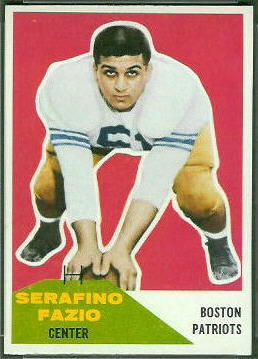 Serafino “Foge” Fazio, a longtime college and NFL coach, died on December 2. Fazio was the head coach at Pitt from 1982 to 1985, before becoming an assistant coach in the NFL. His NFL career included defensive coaching positions with the Falcons, Jets, and Redskins, and five years as a defensive coordinator for the Vikings and Browns.
Serafino “Foge” Fazio, a longtime college and NFL coach, died on December 2. Fazio was the head coach at Pitt from 1982 to 1985, before becoming an assistant coach in the NFL. His NFL career included defensive coaching positions with the Falcons, Jets, and Redskins, and five years as a defensive coordinator for the Vikings and Browns.
Fazio was drafted by the Boston Patriots in 1960, but he did not see playing time as a professional. He did, however, appear on a 1960 Fleer card, pictured here.
October 26th, 2009 |
Published in
Trivia Questions
Here is the latest trivia question.
Question #4: What do the four players pictured on these 1958 Topps football cards have in common?
Scroll down slowly; the answer is after the sponsored links. For more information on a card, click on it or hold your cursor over it.
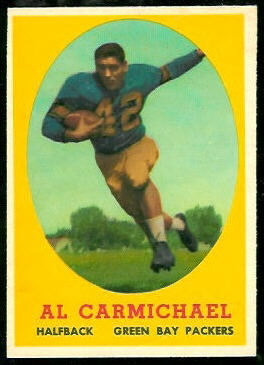
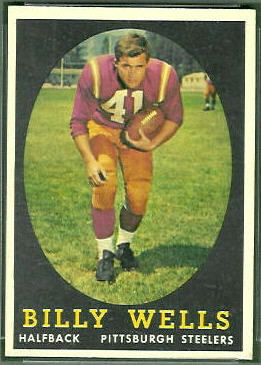
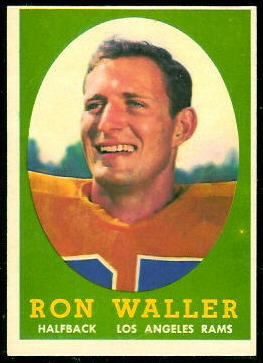
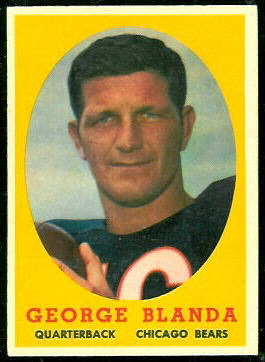
Sponsored Links
Answer: All of them were out of football in 1959, but each of them came back to join an AFL team in 1960. Carmichael went to the Broncos, Blanda and Waller to the Oilers, and Wells to the Patriots.
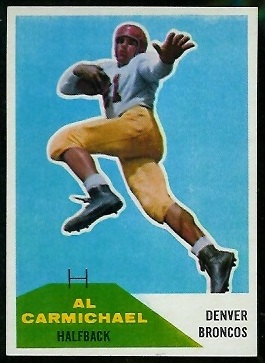
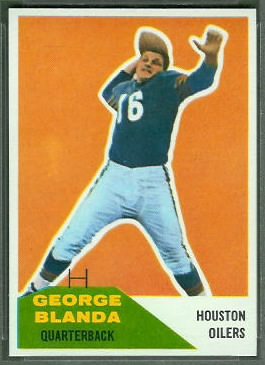
October 21st, 2009 |
Published in
Trivia Questions
Continuing our little quiz:
Question #2: What do the three players pictured on these 1951 Bowman football cards have in common?
Scroll down slowly; the answer is after the sponsored links. For more information on a card, click on it or hold your cursor over it.
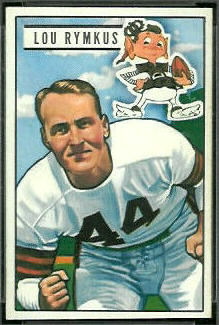
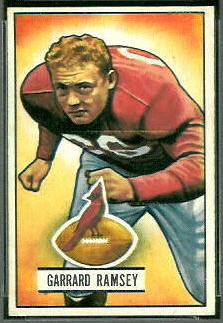
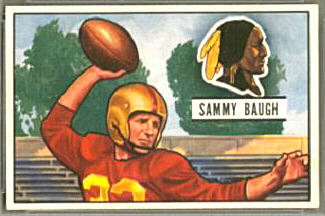
Sponsored Links
Answer: All of them became head coaches in the AFL in its first year, 1960.
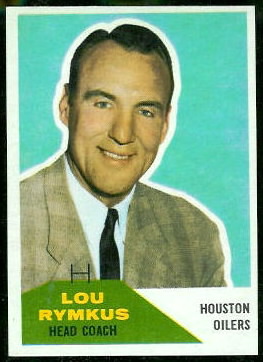
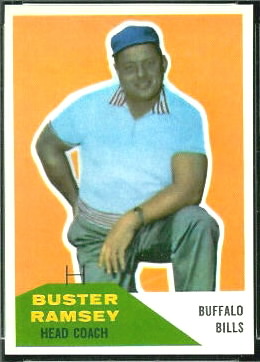
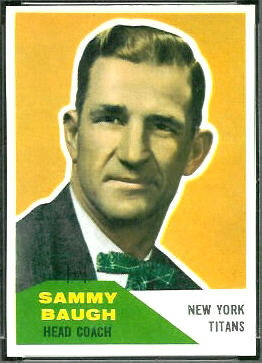
 Ron Drzewiecki turned 80 years old yesterday; he was a running back and kick returner for the Chicago Bears in 1955 and 1957. As far as I know, Drzewiecki did not appear on a football card with the Bears, but he later appeared on a 1960 Fleer card with the Oakland Raiders. Drzewiecki signed to play with the Raiders in April, 1960, but I could not find any 1960 stats for him, so apparently he did not play in the regular season.
Ron Drzewiecki turned 80 years old yesterday; he was a running back and kick returner for the Chicago Bears in 1955 and 1957. As far as I know, Drzewiecki did not appear on a football card with the Bears, but he later appeared on a 1960 Fleer card with the Oakland Raiders. Drzewiecki signed to play with the Raiders in April, 1960, but I could not find any 1960 stats for him, so apparently he did not play in the regular season. 























